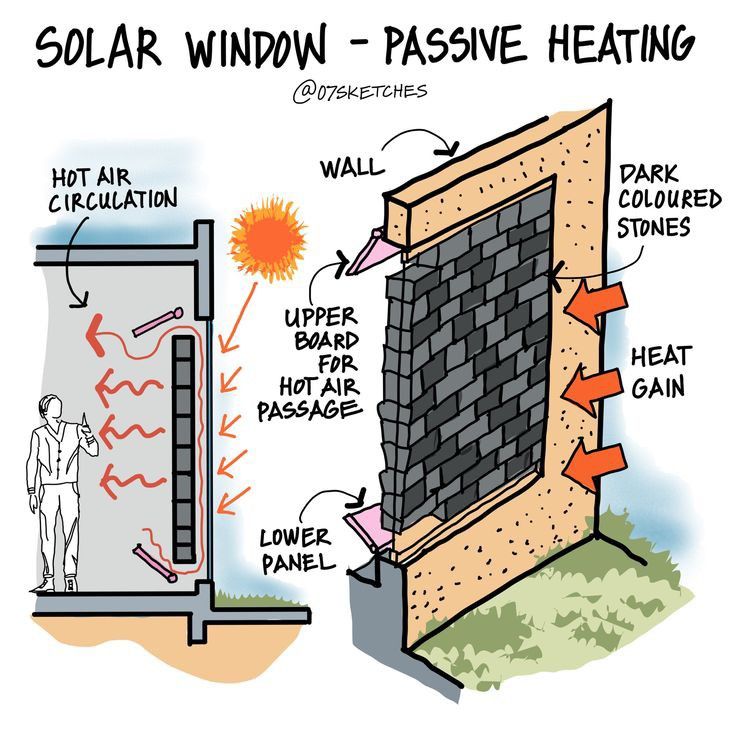
As energy costs continue to rise, homeowners are increasingly looking for smart, sustainable ways to heat their homes. An elegant diagram of a “Solar Window” has been gaining attention online, showcasing a brilliant method for passive heating that harnesses the free energy of the sun. This system, a classic design known as a Trombe wall or a thermosiphon air heater, is a powerful tool for reducing heating bills in winter.
However, a crucial design oversight can turn this winter blessing into a summer curse. Understanding how the system works, and how to correct its most common flaw, is key to unlocking its true potential.
Part 1: The Genius of Passive Solar Heating
The diagram, created by the design account @07sketches, illustrates a beautifully simple process that works without any moving parts, pumps, or electricity.
Step 1: The Solar Collector and Heat Gain
The system is essentially a glass-fronted air collector built onto the exterior of a sun-facing wall (south-facing in the Northern Hemisphere). Sunlight passes through the glass and strikes a wall of dark-colored stones. The dark, heavy material acts as a thermal mass, absorbing a massive amount of solar energy and converting it into heat.
Step 2: The Natural Air Engine
This stored heat radiates into the sealed air gap between the stones and the glass. The air in this narrow channel becomes very hot.
Step 3: Silent, Hot Air Circulation
As the trapped air heats up, it expands, becomes less dense, and naturally rises. An “upper board for hot air passage”—an upper vent—allows this buoyant hot air to flow directly into the living space. This movement creates a gentle suction effect, drawing cooler, denser air from the room’s floor level into a “lower panel” or vent. This creates a continuous, silent, and completely free “hot air circulation” loop that consistently warms the home throughout the day.
Part 2: The Critical Mistake – The Summer Overheating Problem
The design as shown in the diagram is incredibly effective at its primary job: capturing heat. But this leads to a critical question: What happens in summer?
The very properties that make the solar window a perfect winter heater make it a powerful, unwanted furnace during warmer months. Without any modification, the system will continue to absorb intense summer sun and pump hot air into the house, forcing air conditioners to work overtime and driving up electricity bills. This is the single most common mistake in amateur passive solar design: building a great heat collector without a plan for turning it off.
Fortunately, the solutions are as elegant as the system itself.
The Correction (Solution 1): Smart Shading
The best approach is to prevent the summer sun from hitting the collector in the first place. This can be achieved with a precisely calculated roof overhang. In the summer, the sun is high in the sky. A properly sized overhang will cast a shadow over the solar window, blocking the sun’s rays. In the winter, the sun is much lower in the sky. Its rays can travel underneath the overhang to warm the collector. This makes the system seasonally responsive without any moving parts.
The Correction (Solution 2): Summer Venting
Another effective method is to build operable vents into the collector. By adding a vent from the top of the air channel to the outside, you can simply exhaust all the collected heat outdoors during the summer. This can even create a beneficial “chimney effect,” helping to pull stale air out of the house and improve ventilation.
Part 3: Expert Commentary on a Complete System
“Trombe walls and solar air heaters are fantastic, robust technologies, but they must be designed as a complete system, not just a hot box on a wall,” says Dr. Evelyn Reed, a (fictional) senior fellow at the ‘Institute for Sustainable Architecture.’
“The most common mistake we see is people building the collector but forgetting the controls—namely, the summer shading strategy,” Dr. Reed explains. “A system without controls can easily become a liability, fighting your cooling system in the summer. A secondary issue we see in older designs is reverse siphoning on cold nights, where the loop can flow backward and cool the house. This is easily solved with simple backdraft dampers on the vents. When designed correctly, with attention to both the heating and cooling seasons, it’s one of the most elegant and durable ways to live comfortably with solar energy.”
In conclusion, the “Solar Window” is more than just a clever idea; it’s a proven technology. By understanding that it is part of a whole-house system that must manage the sun’s energy year-round, homeowners in temperate and cold climates can use it to create a home that is not only more affordable to run, but also more resilient, sustainable, and comfortable through every season.